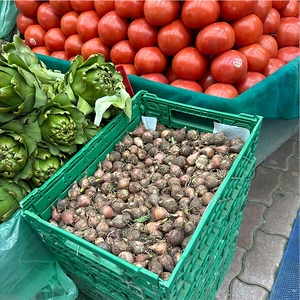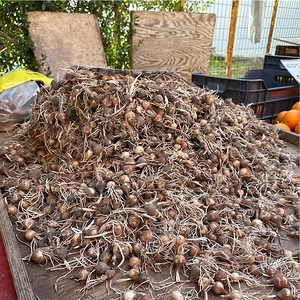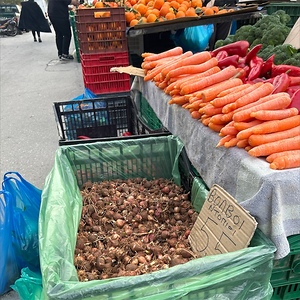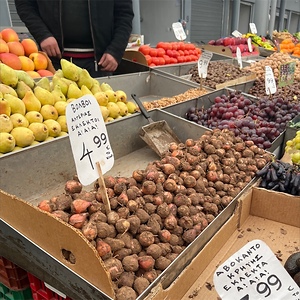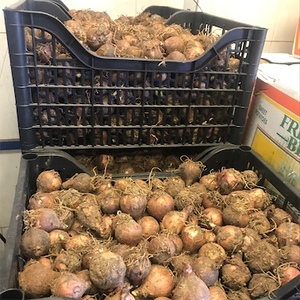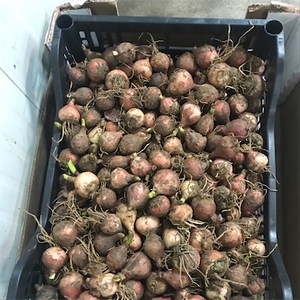


Askordoulakous Bulbs
Estimated Inventory, lb : 0
Description/Taste
Askordoulakous are small, oval to tear-drop-shaped bulbs averaging 2 to 3 centimeters in diameter and 3 to 4 centimeters in length. Each bulb varies in size and appearance, depending on growing conditions and maturity at harvest, and typically showcases a curved base tapering toward a narrow top. The bottom of each bulb has a rough, woody base with a grouping of brown roots, and the exterior is comprised of thin layers of flaky, parchment-like skin. The layers are tightly adhered and appear in pink, red, and tan shades. Some bulbs are sold covered in a layer of soil, giving them a brown look. As each exterior layer is peeled away, the flesh becomes lighter, fading into pale pink, white, and green hues. The bulb's interior is springy, firm, and crisp, secreting a sticky, mucilaginous liquid that dissipates with soaking and cooking. When the bulbs are sliced in half, the flesh showcases thin rings like the rings found in onions. Askordoulakous emits a mild, earthy, and subtly green aroma and is traditionally eaten after it has been prepped and cooked. The bulbs have an intensely bitter and earthy taste, often balanced with other ingredients like olive oil and vinegar. Once properly cleaned, boiled, and prepared in culinary dishes, the bitterness lessens, and the bulbs develop a bitter-sweet taste with mild, earthy, and onion-like nuances.
Seasons/Availability
Askordoulakous are available from late winter through early spring, often between February and mid-April. The bulbs are harvested before the plants produce their purple flowers in late spring through early summer.
Current Facts
Askordoulakous, botanically classified as Leopoldia comosa, are edible, underground bulbs of a flowering plant belonging to the Asparagaceae family. In English, the species is commonly known as the Tassel Hyacinth or Tassel Grape Hyacinth and is named for its purple-blue flowers that form at the top of upright green stems, reaching 20 to 50 centimeters in height. These flowers are favored for their scent and ability to attract beneficial pollinators. Throughout the Mediterranean, Leopoldia comosa is more commonly known for its underground bulbs that are unearthed and prepared as a seasonal culinary delicacy, especially in Greece and Italy. Askordoulakous is a Greek name for the bulbs, and there are many other names used regionally throughout the country, including Askordoulakas, Askordoulaki, Ascordulakoi, Askordoulaks, Skordoulaki, Volvi, and Volvoi. In Southern Italy, the bulbs are mainly called Lampagioni or Lampascioni. The story of Askordoulakous in Greece begins in ancient times when rural communities would forage the bulbs as a culinary and medicinal ingredient. The bulbs are labor-intensive to harvest as they can be found as deep as fifteen centimeters in the ground, and the forager must not damage the bulb in the extraction. Askordoulakous also requires a multi-step process to prepare for culinary preparations. Despite these time-consuming requirements, Askordoulakous remains a traditional foraged ingredient in the modern day and has since been introduced into cultivation to meet steady seasonal demand.
Nutritional Value
Askordoulakous has been noted in ancient Greek texts for its antioxidant, antimicrobial, and anti-inflammatory properties. The bulbs were mentioned in the writings of Hippocrates and Dioscorides and were said to lessen symptoms associated with bodily pain, sprains, and stomach issues. They were also used for their diuretic properties and as a method to naturally lower cholesterol. While less known, some natural medicines mention that the bulbs, when combined with herbs, are topically used to treat dandruff and skin conditions, but more research needs to be conducted before conclusions can be made. It is important to note that the sticky liquid released when the bulbs are cut may cause irritation or dermatitis to individuals with sensitive skin. Gloves can be worn to reduce contact with the liquid.
Applications
Askordoulakous are edible after a series of cleaning, prepping, and cooking processes. The bulbs are trimmed to detach their rough, woody base, and the exterior layers are stripped to remove dirt. Once initially cleaned, the bulbs are boiled for an extended period to extract the bitter components. This process is repeated several times with new water, and each chef and household has their preferences for how many times these steps are practiced. In Greece, Askordoulakous is traditionally immersed in a mixture of vinegar and olive oil after boiling to preserve the bulbs for extended use. This process creates a type of pickle, and the bulbs will bear a bitter-sweet flavor, depending on how many times they were boiled. These pickled bulbs are customarily served with legume-based soups and meat dishes. They are also served as a salad or tossed with lemon and olive oil as an appetizer, commonly referred to as mezze in Greece. In addition to pickling, Askordoulakous can be coated in a batter of water, flour, and mint and fried as a crisp snack. The bulbs can also be simmered into risotto or cooked and served with seafood, especially octopus. In Italy, Askordoulakous are preserved with herbs, garlic, and oil and served in various culinary dishes. They are also chopped with eggs and flour and fried as an appetizer or tossed into salads with olives, tomatoes, and arugula. Askordoulakous pairs well with herbs such as thyme, parsley, oregano, and mint, spices including turmeric, curry, and asafoetida powder, seafood such as cuttlefish and octopus, and meats such as lamb, pork, poultry, snails, and rabbit. Freshly harvested bulbs will keep up to ten days when stored in a cool, dry, and dark place. Once preserved, the cooked bulbs will keep for six or more months.
Ethnic/Cultural Info
Askordoulakous is a treasured ingredient on the island of Crete in Greece. The bulbs are widely found across the island and are sold loosely in large bins when in season. Askordoulakous is also cultivated in select regions of Crete to meet increasing demand. Wild bulbs are believed to have a stronger flavor and are the desired type among Cretan households. There are also two sizes of wild Askordoulakous seen in markets: larger bulbs grown in the mountains and smaller bulbs found along the coastline. Mountain bulbs are preferred as the fertile soil and cooler climate contribute to the bulbs having a crisp, firm consistency and a larger size. Coastal bulbs are smaller as they grow in sandy soils. During the season of Lent leading up to Easter, Askordoulakous is a traditional side dish served with fakes, also known as Greek lentil soup. The bulbs are viewed as a physical cleansing ingredient during the season of Lent and are believed to help remove impurities from the body in preparation for Easter Sunday. Outside of Easter, Askordoulakous is commonly served coated in olive oil and herbs in Crete as a dish to accompany raki, an alcoholic beverage made from twice-distilled grapes. This dish is often served as a friendly welcome snack for guests visiting households.
Geography/History
Askordoulakous is native to the Mediterranean and has been growing wild since ancient times. The species thrives in fields, vineyards, hedgerows, and hillsides and was historically foraged from wild populations. Throughout history, Askordoulakous has been mentioned in written documents by ancient Greek physicians and naturalists, and the bulbs have also been a part of natural medicines throughout the Mediterranean. It is unknown when the species was selected for commercial cultivation, but growers eventually planted the bulbs for production to meet increasing demand and protect wild populations from being overharvested. Cultivation is still considered relatively small compared to other crops. Askordoulakous has also been exported to other European countries, including England, since the 16th century. Today, Askordoulakous is foraged from wild and cultivated plants and is seasonally sold through local markets in the Mediterranean, mainly Greece and Italy. The Askordoulakous featured in the photograph above was sourced through a market in the city of Rethymno in Crete, Greece.



